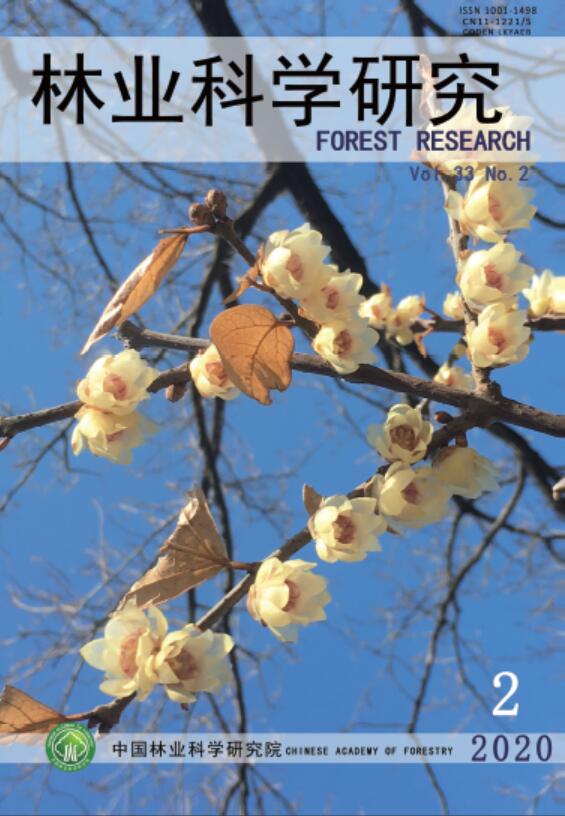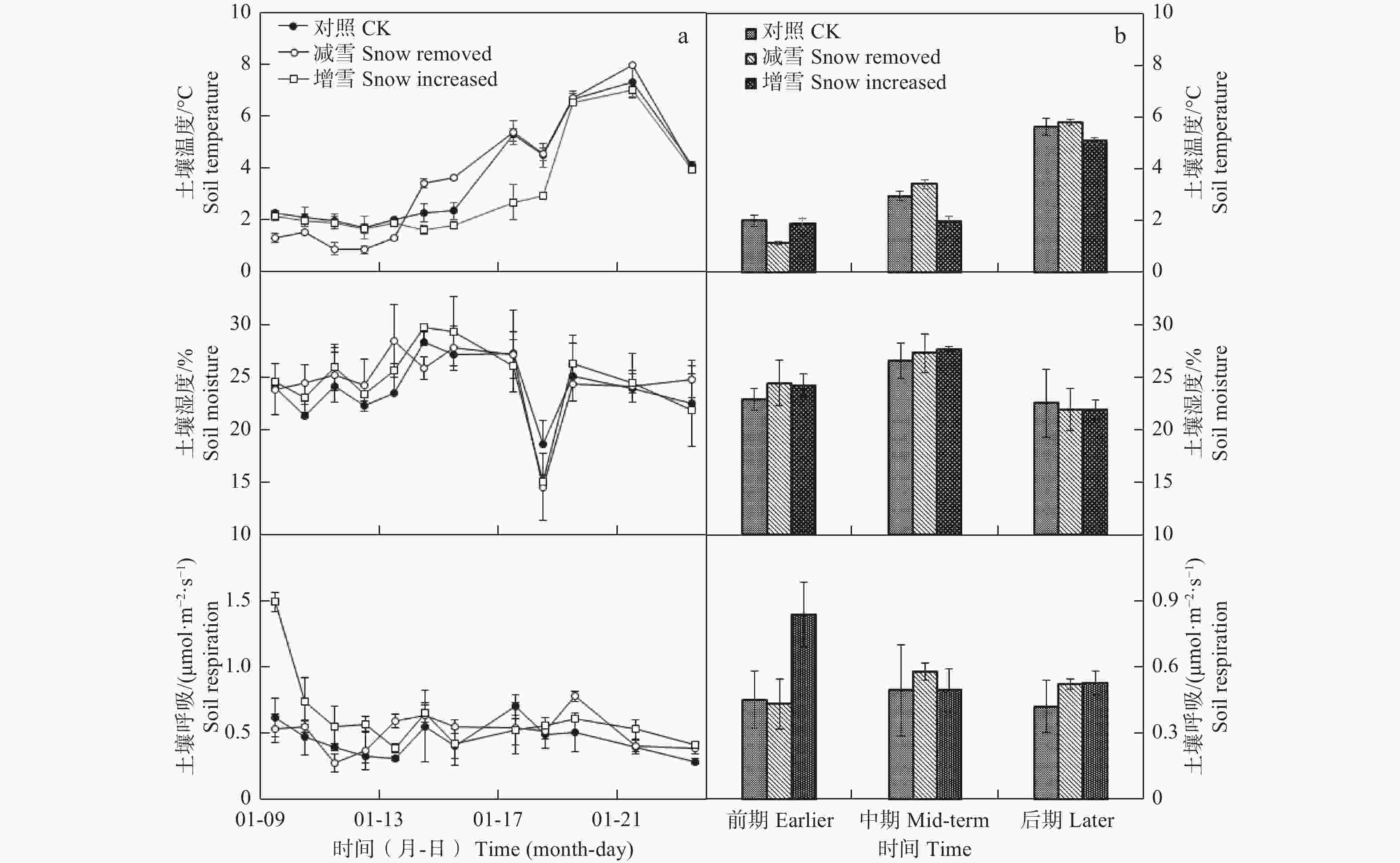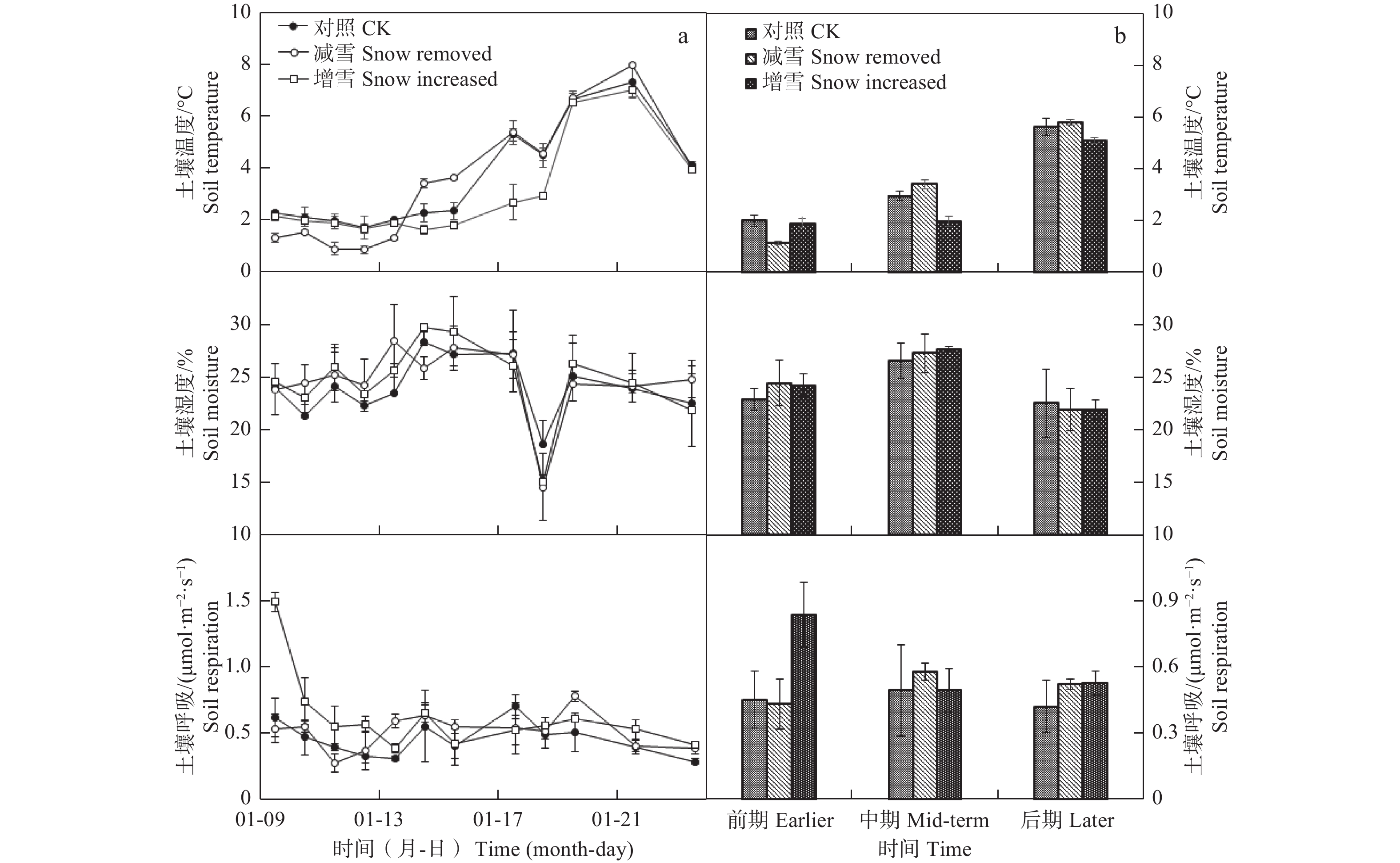-
近年来,全球极端气候[1-2]的一个非常重要的体现是降雪频度和强度的变化[3-4]。研究降雪变化对陆地生态系统碳循环的影响,对于深入理解陆地生态系统碳循环如何响应气候变化具有非常重要的理论和现实意义。土壤碳库是构成陆地生态系统有机碳库的主体[5],土壤呼吸是土壤碳库输出的重要过程[6-7],也是研究全球碳收支最重要的过程之一[8]。研究土壤呼吸的影响因素对理解陆地生态系统碳循环途径及其对气候变化的反馈影响都具有重要意义[9]。冬季土壤呼吸是土壤碳通量的重要组成部分[10-13],也是准确评估碳循环的重要参数,在全球范围内的碳循环过程中扮演着重要的角色。森林生态系统是调控全球变化背景下生态系统碳循环的主要生态系统类型之一,其土壤呼吸对降雪变化非常敏感[10, 14-16]。与天然林相比,人工林更易受极端降雪的影响[17-19],进而改变森林的碳汇格局[2]。因此,人工林被认为是能减缓全球气候变化机制的核心,受到世界各地的关注[19]。目前,我国是世界人工林面积最大的国家[4],人工林面积达6 933万hm2,对陆地碳汇增强的贡献率达39%[20]。然而,在降雪对土壤呼吸影响的研究中,多数集中在自然生态系统[13, 15-16],关于人工林生态系统对降雪变化响应的研究相对缺乏。在对人工林土壤呼吸的研究中,大多仅对生长季土壤呼吸有所研究[21-22],忽略了非生长季的土壤碳输出。此外,少数研究降雪对人工林土壤呼吸的影响大部分集中在全球积雪时间较长的高海拔地区[14]或高纬度地区[23],对温暖地区,尤其是气候过渡带(北亚热带-暖温带)这一敏感地区[24-26]的研究较缺乏。因此,开展关于气候过渡带人工林土壤呼吸对于极端降雪事件响应的影响,具有非常重要的理论和现实意义。基于以上问题,本试验选取位于北亚热带-暖温带气候过渡带的信阳市为研究地区,以2018年1月4–7日信阳市的一次极端降雪为研究契机,根据信阳气象局数据资料,信阳平均累计降雪51.9 mm,平均积雪深度达29 cm,为1951年有气象记录以来该地降雪的历史最高值,这为研究极端降雪对人工绿地土壤呼吸的影响提供了机会。研究该区域土壤呼吸对气候变化的响应更有助于了解人工绿地碳排放对气候变化的响应,可为精确评估与模拟未来气候变化背景下陆地碳循环过程提供数据支持,具有非常重要的理论和现实意义。
HTML
-
试验地点位于河南大学信阳森林生态系统定位研究站附近的一处面积约75 hm2的人工林内(114°0′31″E,32°8′18″N),海拔109.4 m。该地区年均气温15.3℃,年最低月均气温1.9℃(1月),最高月均气温27.5℃(7月),年均降水量1 061.7 mm,多集中于5–9月。土壤类型为酸性黄棕壤。植被类型为人工林,林龄10 a,乔木树种以马褂木(Liriodendron chinense (Hemsl.) Sargent)为主,马褂木密度约1 100株·hm−2,树高约15 m,胸径8~15 cm。林下植被以细叶苔草(Carex duriuscula C. A. Mey. subsp. stenophylloides (V. I. Krecz.) S. Y. Liang & Y. C. Tang)、山麦冬(Liriope spicata (Thunb.) Lour.)、野胡萝卜(Daucus carota L.)等草本植物为主。
-
在研究地内,根据样地背景情况以及前期观察到的融雪情况,在保证处理间不相互干扰的原则下,选取3个8 m×5 m的区域,在每个区域内选定3个2 m×1.5 m的样方,相邻区域间隔5 m以上。分别进行以下处理:A、去除雪被(减雪),将地上积雪全部去除;B、增加雪被(增雪),将减雪样地去除的雪被添加到样方;C、对照,自然雪被,不做处理。在每个样地中间区域放置3个直径为11 cm的PVC土壤呼吸环,每个呼吸环的总高度为5 cm,埋入地下3 cm,留2 cm在地上。样地布置见图1。
-
整个试验测定从2018年1月9日降雪停止后开始,23日所有处理积雪融化完成1周后结束。利用LI-8100(美国LI-cor公司)每1~2 d测定1次土壤呼吸,按照测定时间内温度相对稳定、对积雪干扰比较小、测定时间内积雪融化程度比较低的原则,测定时间统一选择上午10:00–11:00,且每次每个呼吸环测定时间为1.5 min。
每次测定土壤呼吸时,利用LI-8100自带的热电偶温度测量装置测定10 cm处的土壤温度,利用TDR200(美国Spectrum公司)测定10 cm处的土壤湿度。
在融雪后每个样地利用5 cm土钻采集3钻0~20 cm的土壤混匀,过2 mm筛,用手检法去除石块和根系后,放入冰盒内带回实验室,并进行如下测定:
-
将采集到的土壤用KCl浸提后,利用比色法,采用AMS全自动化学分析仪(法国Alliance公司)测定土壤铵态氮、硝态氮氮含量,并利用二者之和作为可利用性氮含量。
-
利用氯仿熏蒸-K2SO4㓎提法测定土壤微生物量碳、微生物量氮含量。定量称取2份20 g鲜土分别进行熏蒸、未熏蒸,再分别用K2SO4(0.5 mol·L−1)溶液振荡㓎提,㓎提液用滤纸过滤,用总有机碳(总氮)分析仪(德国Elementar公司)测定总碳、总氮,根据测得指标计算土壤微生物量碳、氮含量。
-
采用重复测量方差分析时间及改变降雪处理对土壤呼吸的交互影响。因为部分结果显示处理与时间之间存在显著的交互作用,因此,采用单因素方差分析及LSD多重比较分析不同处理间土壤呼吸、土壤温度、土壤湿度、土壤可利用性氮、土壤微生物量碳、氮含量的差异性。为了突出降雪的主效应,对不同处理的平均值进行计算和比较。为了进一步区分不同时期内雪被变化对土壤呼吸的影响,展现交互作用,整个试验阶段被分成前期(对照处理雪被融化完之前)、(对照处理雪被融化完成、增雪处理雪被融化完之前)、后期(所有雪被融化完成之后),并利用单因素方差分析对每个时期不同处理下的土壤呼吸的差异性进行检验。利用皮尔逊相关分析土壤呼吸与其它指标间的关系。以上分析采用SPSS 16.0(IBM)完成,应用Excel2013软件绘图。
2.1. 样地选择与设置
2.2. 测定指标及方法
2.2.1. 土壤铵态氮、硝态氮含量的测定
2.2.2. 土壤微生物量碳、氮含量的测定
2.3. 数据分析
-
不同降雪处理下土壤温度均表现出显著的时间波动(表1),即土壤温度随降雪的融化而变化;随着试验进行,土壤温度呈升高趋势(图2a)。表2表明:不同处理下,土壤温度存在差异,在增雪处理下土壤平均温度显著低于其它2种处理。时间阶段与处理间有交互作用(表1、图2b),在试验前期,减雪处理下土壤温度显著低于其余2种处理;试验中期,减雪处理下土壤温度最高,增雪处理下土壤温度最低;试验后期,增雪处理下土壤温度显著低于其余2种处理。
因子
Factor土壤温度
Soil temperature/℃土壤湿度
Soil moisture/%土壤呼吸速率
Soil respiration/(μmol·m−2·s−1)F P F P F P 时间Time
109.441 <0.001 49.822 <0.001 16.084 <0.001 处理Snow
18.018 <0.001 0.401 0.674 7.642 <0.001 时间×处理Time×Snow 52.327 <0.001 3.505 <0.001 14.596 <0.001 Table 1. Results of ANOVA on the effects of snowfall treatment and time on soil temperature, moisture and soil respiration
处理
Treatments土壤温度
Soil temperature
/℃土壤湿度
Soil moisture
/%土壤呼吸
Soil respiration
/(μmol·m−2·s−1)对照CK
3.55±0.18a 23.99±1.92a 0.46±0.05b 减雪
Snow removed3.46±0.07a 24.56±1.99a 0.51±0.02b 增雪
Snow increased3.01±0.11b 24.61±0.63a 0.62±0.02a 注:表中同列不同字母表示不同处理间差异显著(P<0.05)。
Notes: Different letters in the same column in the table indicate significant differences between different processing.(P<0.05).Table 2. Mean values (±SE) of soil temperature, moisture and respiration under different treatments
不同时间阶段下土壤湿度有显著变化,在试验中期,土壤湿度显著高于其余2个时期;不同处理下土壤湿度无显著差异(表1、2),且处理与时间阶段有显著交互作用(表1、图2b)。
-
对比3个试验阶段,土壤呼吸有显著的时间波动,各处理显著影响了土壤呼吸(表1)。综合整个试验过程,增雪处理下,土壤呼吸速率比去除雪被和对照处理下分别提高了0.11、0.16 μmol·m−2·s−1(表2)。此外,改变降雪处理对土壤呼吸的影响在不同试验阶段并不一致,即改变降雪与处理时间之间存在显著的交互作用(表1)。在试验前期,增雪处理下土壤呼吸速率显著高于减雪处理和对照处理;在试验中期和后期,增减雪处理对土壤呼吸均无显著影响(图2b)。
-
图3表明:改变降雪对土壤铵态氮(P=0.92)、硝态氮(P=0.40)含量均无显著影响,但与对照相比,减雪、增雪处理下硝态氮、铵态氮含量均有增加;可利用性氮含量在不同处理下差异也不显著(P=0.33),但增、减雪处理下均提高了可利用性氮的含量。
与对照相比,在增、减雪处理下,人工林土壤微生物量碳(MBC)含量有微弱的提高,而微生物量氮(MBN)含量在减雪下减少,在增雪下有微弱的提高,但在不同处理下,MBC(P=0.56)或MBN(P=0.20)的含量变化并不显著(图3)。
-
表3表明:在试验早期,土壤呼吸与土壤温度之间存在接近显著的正相关关系,但在试验中期或后期,土壤呼吸与土壤温度之间无显著相关性。综合整个试验,土壤呼吸与土壤温度间存在显著的负相关关系。不管在试验的各个阶段,还是整个试验过程中,土壤呼吸均不受土壤湿度的调控。整个试验过程土壤呼吸的平均值与微生物量碳之间存在接近显著的正相关关系(表3),土壤呼吸与微生物量氮、铵态氮、硝态氮、可利用性氮含量之间均无显著的相关关系。
自变量Dependent variables 早期Earlier 中期Mid-term 后期Later 平均Mean R P R P R P R P 土壤温度Soil temperature 0.333 0.090 0.185 0.357 −0.117 0.562 −0.740 0.000 土壤湿度Soil moisture −0.012 0.953 0.224 0.262 0.238 0.232 0.240 0.228 微生物量碳MBC − − − − 0.291 0.141 0.351 0.073 微生物量氮MBN − − − − 0.051 0.799 0.291 0.140 铵态氮含量NH4+−N content − − − − 0.137 0.496 0.174 0.385 硝态氮含量NO3−−N content − − − − −0.037 0.856 −0.039 0.848 可利用性氮含量Available N content − − − − 0.120 0.553 0.154 0.443 Table 3. Results (R and P value)between soil respiration and other environmental factors
3.1. 土壤温度与湿度
3.2. 土壤呼吸对降雪改变的响应
3.3.
降雪变化对铵态氮(${\rm{NH}}_4^{+} $ -N)、硝态氮(${\rm{NO}}_3^{-} $ -N)、可利用性氮(Available-N)、微生物量碳(MBC)、微生物量氮(MBN)的影响
3.4. 土壤呼吸与其它因子之间的关系
-
已有研究表明,土壤物理性质(温度、湿度)、化学性质(养分含量)、与生物环境(微生物生物量与微生物活性)均会调控土壤呼吸[6-7, 10]。不同生态系统及处理下生物与非生物环境因子的差异均可引起土壤呼吸的变化,因此,关于土壤呼吸改变机理研究是一个非常复杂的问题。本研究的观测数据显示,对照样地平均冬季土壤呼吸速率为0.29~0.70 µmol·m−2·s−1,整个试验期平均土壤呼吸速率为0.46 µmol·m−2·s−1(表2),占本地区水杉人工林旱季土壤呼吸速率[26]的30.5%,占天然林生长季平均土壤呼吸速率[27]的18.3%,足以说明非生长季土壤呼吸在该地区土壤碳排放中占有相当重要的地位,需要引起足够的重视。本研究中的土壤呼吸速率与北美亚高山森林生态系统[10]、奥地利高山针叶林[11]、美国哈佛森林[13]、川西亚高山针叶林[14]、岷江华山松人工林[28]等地进行的观测结果基本一致,但高于Wang等[11]在我国塞罕坝北方针叶林生态系统的测定结果(0.15~0.28 µmol·m−2·s−1)和Gao等[23]在沈阳落叶松林的结果(0.32 µmol·m−2·s−1)。土壤呼吸速率这一地域差异的可能原因有以下几点:首先,大量研究证实,土壤呼吸速率与温度有关[2, 13, 28-29],此次试验地区冬季土壤均温3.6℃,显著高于塞罕坝地区(−5℃)和沈阳地区(−10.5℃),故在本研究中土壤呼吸速率较高;其次,信阳的年均降水(1 061.7 mm)显著高于塞罕坝地区(450.1 mm)和沈阳地区(726 mm),较高的年度降水量和土壤湿度也可能是本研究中土壤呼吸速率较高的原因之一。此外,不同研究地生物群落、土壤结构与质地的差异也会导致土壤呼吸的地区性差异。
本研究结果表明,增雪显著提高了土壤呼吸,这一结果与多数已有研究的结果一致[15, 23, 29]。增加雪被提高土壤呼吸的主要原因有以下几点:第一,增加雪被提高土壤温度和土壤湿度,进而提高土壤呼吸[15, 23];第二,增加雪被可以提高植物根系与微生物的活性[15, 30],进而提高土壤呼吸速率。第三,单次降雪事件对土壤呼吸的影响,通常体现在融雪产生的土壤呼吸脉冲效应,通常融雪量越大,脉冲效应越明显[15],这与文中的试验现象一致。本研究中,增雪处理下土壤呼吸速率的提高主要发生在试验前期,所有积雪融化之前,在此阶段增雪处理下土壤温度、土壤呼吸速率均高于无雪被的处理,且土壤温度与土壤呼吸在该阶段为接近显著的正相关关系,表明增雪后土壤温度的变化是土壤呼吸的主要调控因子。由于本研究地点位于亚热带-暖温带气候过渡带,总体环境温度较高,积雪时间短,融雪速度快,除了在试验前期有积雪的处理(对照与增雪)土壤温度高于雪被去除处理之外,其它试验阶段有积雪处理的土壤温度反而更低,这一现象与哀牢山亚热带常绿阔叶林雪灾后的土壤温度波动是一致的[4]。虽然较长的积雪融化时间造成增雪处理的土壤温度低于其它处理,但这一时期土壤温度对土壤呼吸并无显著的调控作用,这些整体变化趋势也符合积雪的土壤呼吸脉冲效应规律。由于本地降雨多,土壤湿度大,降雪对土壤湿度无显著影响。因此,土壤呼吸速率的变化不能归因于湿度的变化。此外,已有研究表明,土壤呼吸底物的变化主要是由凋落物变化引起的[31-32]。该地人工林定期进行一定的管理,对凋落物进行清理,枯枝落叶很少,且降雪时树叶早已经凋落并清理完毕,因此,本研究中降雪引起的土壤呼吸变化与降雪引起的底物变化基本无关。结合土壤呼吸的调控因子,尽管大量数据表明微生物与根系活性可以调控土壤呼吸[6-7, 10],理论上降雪会影响微生物活动,进而影响微生物量碳氮及土壤可利用性氮,但这种影响在单次降雪事件下非常微小,可以忽略不计,因此,本研究中土壤呼吸的变化与土壤微生物量无关。
前人多数雪被去除试验结果表明,去除雪被之后,土壤温度降低[10, 14-15],冻融循环次数增加[14],凋落物分解速率及氮矿化速率降低[30],底物浓度降低[15],最终导致土壤呼吸速率下降;但也有研究表明,雪被去除之后,土壤冻结程度大大提高,植物根系死亡率上升,死亡的根系对土壤呼吸的激发效应提高了土壤呼吸速率[33]。本研究中,去除雪被对土壤呼吸速率无显著影响,这与以上研究结果均不一致[14-15, 23, 30, 33],但这一结果与一项在亚高山草地进行的研究结果具有相同的趋势[16]。与前期的大量研究不同的是,本次降雪之后本地的土壤温度均在0 ℃以上,积雪处于持续融化阶段,雪被去除对土壤温度并未带来显著影响;较高的环境温度也决定了雪被去除不可能通过冻害影响植物根系的死亡率。此外,由于人工林树木密度大,林下植被结构单一,积雪对底物输入的影响不大。因此,土壤呼吸速率并未随雪被去除而发生变化。结合以上结果及本地较少的降雪频率和较低的降雪强度,可以推测,在北亚热带-暖温带气候过渡带,降雪的减少对土壤碳排放的影响不大。
需要说明的是,本次降雪是在1月4日至7日发生,试验设置开始于1月9日,未在降雪前进行减雪设置挡雪装置,缺少一个天然无降雪对照处理。无法完全消除自然降雪过程对土壤湿度的影响,因此,关于此问题的研究有待于后期更详细的试验论证。
-
本研究发现,极端暴雪可能提高气候过渡带人工林的土壤呼吸速率,但这种提高受到降雪量的影响,30 cm左右的降雪并未显著影响土壤呼吸速率,但是如果积雪深度继续增加,土壤碳排放速率会有所增强。此外,本研究发现,积雪深度在不同的融雪阶段对土壤呼吸的影响幅度不一致,降雪对土壤呼吸的影响主要发生在积雪完全消融之前这一阶段。因此,降雪量及融雪时间对土壤碳通量的影响是未来生态系统碳循环评估中需要考虑的重要问题之一。











 DownLoad:
DownLoad:

